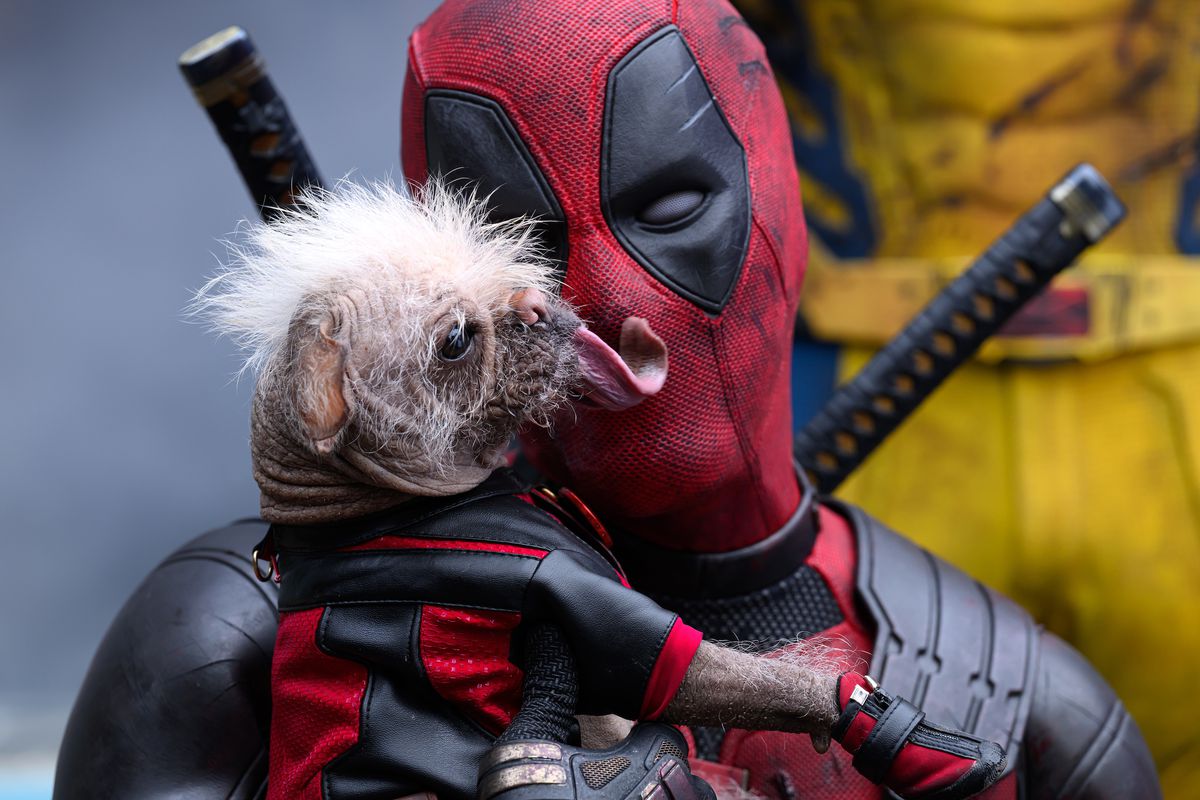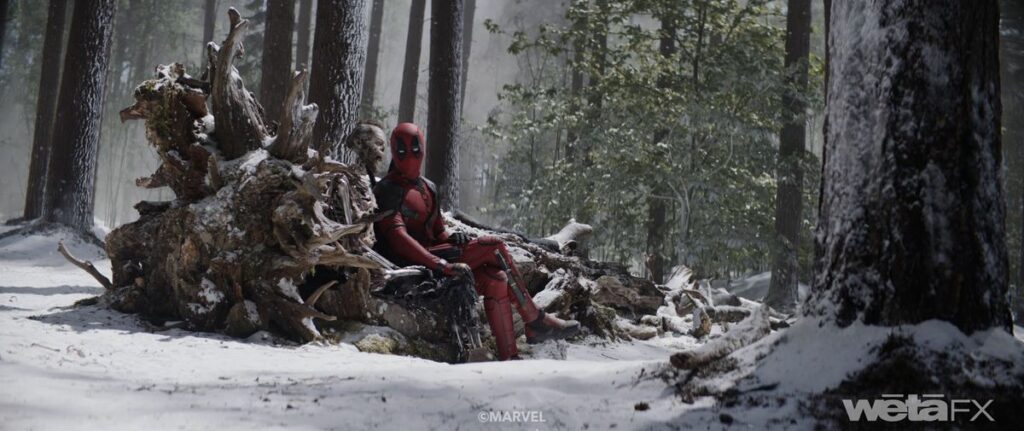When a rep for New Zealand-based company Wētā FX asked whether Polygon wanted to interview someone about the company’s work on Deadpool & Wolverine, one line item on its project list made the answer an instant yes. Wētā, co-founded by Lord of the Rings franchise director Peter Jackson, has worked on all three Deadpool movies, particularly on managing Deadpool’s masked facial expression. Still, the project I had the most questions about was “a digitally enhanced Wolverine corpse.” Turns out that Deadpool & Wolverine star / producer / co-writer Ryan Reynolds has strong opinions about the amount of skin a decaying body needs for comedy purposes — and for teasing co-star Hugh Jackman. Wētā was there to help.
[Ed. note: Spoilers ahead for the opening sequence of Deadpool & Wolverine — and the end of 2017’s Logan.]
Image: Marvel Studios/Wētā FX
The latest Deadpool movie opens with Deadpool (Reynolds) telling the audience he’s about to desecrate the much-praised tragic ending of 2017’s Logan, the movie that supposedly marked both Wolverine’s death and Hugh Jackman’s retirement from playing the character. In need of a spare Wolverine due to multiversal shenanigans, Deadpool finds Logan’s grave and digs up his body, expecting him to have healed and revived, due to his famous healing factor.
Instead, he finds a dried-out mummy. It’s a thin layer of rotting, desiccated skin and muscle over Wolverine’s adamantium-laced skeleton — which Deadpool uses as an improvised weapon, slaughtering an entire team of Time Variance Authority soldiers with what’s left of Logan’s corpse.
In the version of the scene shot by director Shawn Levy and performed by Reynolds, there was no mummy, says VFX supervisor Daniel Macarin. “Originally, they were going to do a kind of prosthetic dead Wolverine that he rips out of the ground,” Macarin says. “And then as they were thinking about it, they’re like, Well, if he has so much skin or organic material on his body, wouldn’t people say, ‘Why doesn’t he just heal? Why doesn’t he come back to life? Why doesn’t something happen?’ There might be a question there of, like, Is there going to be an extra scene where, like, his eye opens, and suddenly there’s this zombie Wolverine in the world?
“So to get away from that, in the end they decided, Let’s make it a skeleton — just an adamantium skeleton. People will understand it. It won’t cause confusion. You know the skeleton isn’t going to start walking around. That’s the better idea. So that’s how they shot the sequence.”

Image: Marvel Studios/Wētā FX
Macarin confirms that in the original footage, Reynolds is using an artificial skeleton as a weapon: “That prop was real. Even when he’s just whipping it back and forth and hitting TVA agents with it, he’s hitting them with the prop.”
But afterward, Reynolds watched how the sequence looked on screen and had second thoughts about how to make it funnier.
“Ryan was like, Yeah, it works — but here’s what I want to do. I want to desecrate the body of Hugh Jackman, and I really want to take this to the next level. I want Hugh to see it, and I want him to start laughing,” Macarin says.
In Macarin’s retelling, Reynolds decided there was a way to clear up any confusion about Logan’s possible revival: “Let’s put some skin on his face […] and when it’s time for Hugh Jackman’s credit, we’re going to rip the skin off and reveal [the skull]. What do you guys think? And we were like, Ripping skin. Yeah. OK. Yeah, no, that sounds good. So we got our team on it, and we started taking Hugh’s likeness and trying to see how much of it we could put into a zombie face. […] We talked about having little dangly bits of skin that could fall off, and whether his eye comes out when he gets bashed into TVA agents. There were a lot of creative conversations on what we were allowed to do with it, and what would make it more or less funny for the moment.”
Reynolds took a similar hands-on tack with other aspects of the production, Macarin says, particularly around how Deadpool’s facial expressions play through his mask. One of Wētā’s effects duties on Deadpool & Wolverine — and the previous two Deadpool movies, produced by 20th Century Fox — was managing the consistent look and feel of Deadpool’s mask. While scenes for these movies were shot with a practical costume version of the mask, Deadpool is digitally enhanced to make his emotions clearer — to make his eyes narrow or widen in a way an actual mask can’t, or to let microexpressions like a concerned forehead crease or a smirk come through.
Macarin says Reynolds would sometimes watch footage from the movie and be concerned that his facial performance wasn’t selling the emotion enough to register for the mask team.
“We have such a great relationship with Ryan that we’ve had for so long,” Macarin says. “He feels very, very comfortable sending us videos on his phone, or calling us up, and saying, ‘Hey, I want to try this a couple different ways. This is what I did on the day. Let’s try seeing it faster.’ Or, ‘Let’s try this different line. I might want to say this other thing. Let me know what you think that would look like, how that would feel.’”
Macarin says Reynolds normally just relies on the Wētā team’s experience with his face to build these changes: “He gives us a lot of trust. We’ve been studying his face for so many years, we do have a good idea of how he might say [a newly added line], and how the moment works in a kind of Ryan Reynolds model.” But occasionally, Reynolds would also shoot new reference footage “for very specific moments where he wants to either try a few options out, or where he really has a specific idea in mind.”

Photo: Jay Maidment/Marvel Studios
One big example on Deadpool & Wolverine: “Any time he was interacting with Dogpool.” Reynolds particularly wanted to make sure Deadpool’s emotions registered clearly on screen when he reunites with Dogpool (played by Peggy, aka “Britain’s ugliest dog”).
“That moment when Dogpool comes through the portal and Deadpool drops to his knees — it was really, really important for Ryan that people understood the love in Deadpool’s face, and his absolute happiness, and his reaction to Dogpool jumping into his arms,” Macarin says.
“And because Deadpool’s mask has such an inverted-V [shape], that gives him a kind of neutral, angry look, which is really, really cool for action scenes, but not great for those kinds of moments. So he was like, I want you to flip that V all the way up, and I want those inner brows really high. He is just in love for that moment, and I want to feel it. And he sent us video of [the facial expression he wanted]. We all laughed, but we understood what he was after.”
Deadpool & Wolverine is in theaters now.

